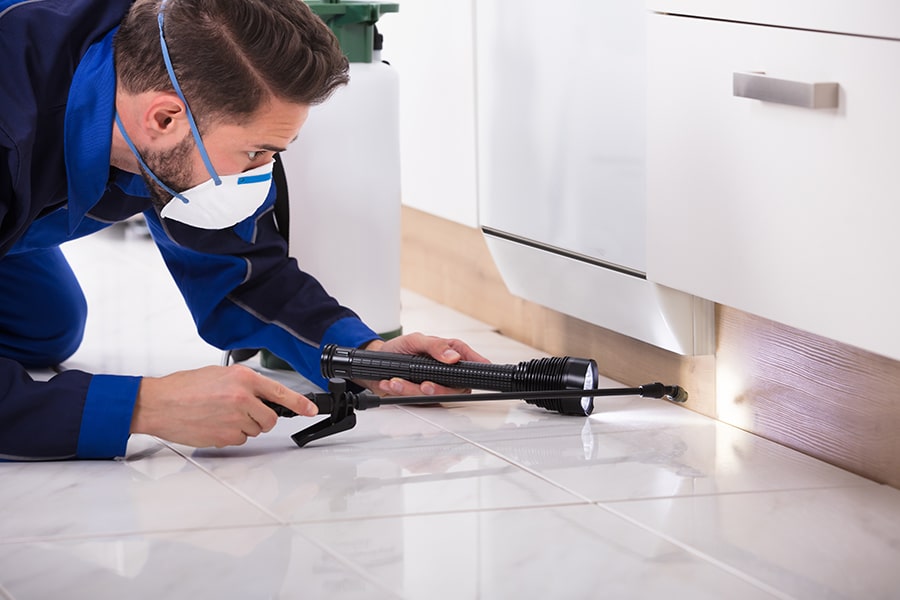Pests can cause a significant amount of damage. On top of these repairs, getting rid of a pest infestation can be costly. To prevent pests from becoming a future issue after buying a home, many mortgage lenders will require that a pest inspection be done.
If you’re planning on using a VA loan, you might need a pest inspection to qualify. These requirements are most frequent in areas where pests and termites are common. More than 30 states require a termite and pest inspection. Here’s everything you need to know about the process for pest inspection for VA loans.
How Do Pest Inspections For VA Loans Work?
When to Conduct a Pest Inspection
To first step in conducting a pest inspection is finding out what the requirements are in your area. Some regions have higher likelihoods for certain pest infestations so an inspection is not always required for a VA loan application.
Your lender might request a termite inspection report as part of your loan application. If not, you’ll want to look into your state or county’s requirements. Even if your loan application does not require a pest inspection, consider what the risks are for your area. If there is still a possibility that a pest problem could exist on the property, consider having an inspection done regardless.
Once you’ve identified that you need a pest inspection for your home loan, you’ll need to find an inspector. Pest inspections are carried out as part of the closing costs of the home-buying process. They are usually done at around the same time as the VA appraisal and home inspection. At this point, professional pest inspectors will check the house for signs of both pests and pest damage.
What Do Pest Inspections Look For?
While termites are one of the biggest concerns when it comes to pest infestations, your inspector will look out for all kinds of unwanted pests. There are many different insects and other species that can cause damage to property. The risk of some pests will depend on the climate and the location. Most inspectors will be on the lookout for the following critters.
- Carpenter ants
- Termites
- Bedbugs
- Spiders
- Snakes
- Rodents
- Moths
- Scorpions
The most tell-tale sign of termites is damaged wood, but there are many signs inspections consider to identify a termite problem. The inspector will let you know if your potential home shows signs of wood-destroying insects or any other unwanted pests.
Pest Inspection Report
The inspector will provide you with a detailed report on their findings. The report will detail if the inspection showed signs of pests, where the pest problem is, and if there is any resulting damage.
The pest inspection report might also recommend pest control treatments to get rid of the critters. The treatment to correct termite infestations or pest damage must adhere to the VA loan guidelines. If the inspection yielded pests, you might need to get another inspection after you’ve treated the problem.
If the report gives confirmation that the property is pest free, you can submit the paperwork to your lender. The problem-free pest inspection report can then be submitted to your mortgage application file for your VA home loan.
When is a VA Termite Inspection Required?
The specific inspection requirements for a VA loan depend on the state that you live in. Check what the probability of infestation is for your area. Homes located in states or regions where the probability of infestation is either “moderate to heavy” or “very heavy” will likely require a termite pest inspection.
VA Loan Termite Inspection Requirements by State
What States Require a Pest Inspection for a VA Loan?
There are many states in the U.S. that have a moderate or high risk for termites and other pests. The following is a list of areas in which pest inspections are required for a VA loan.
- Alabama
- Arizona
- Arkansas
- California
- Connecticut
- Delaware
- Florida
- Georgia
- Hawaii
- Iowa
- Illinois
- Indiana
- Kansas
- Kentucky
- Louisiana
- Massachusetts
- Maryland
- Mississippi
- Missouri
- North Carolina
- Nebraska
- New Jersey
- New Mexico
- Nevada
- Ohio
- Oklahoma
- Pennsylvania
- Rhode Island
- South Carolina
- Tennessee
- Texas
- Utah
- Virginia
- West Virginia
- Washington, D.C.
What Other Areas Require a Pest Inspection for a VA Loan?
If you do not live in one of the states where pest inspections are required, that does not mean that you do not need one for a VA loan. Below is a list of states in which a pest inspection for VA loan requirement is determined by county.
If your state is listed below, you can check online or ask your lender to find out if a termite inspection is required in your county for a VA loan application.
- Michigan
- New Hampshire
- New York
- Vermont
- Wisconsin
What Are Discretionary Pest Inspection States?
The following states are discretionary requirement states. This means that the option to issue a requirement for a pest inspection for VA loan is up to the lender.
- Alaska
- Colorado
- Idaho
- Maine
- Minnesota
- Montana
- North Dakota
- Oregon
- South Dakota
- Wisconsin
- Wyoming
VA Loan Termite Inspection Costs
Who Pays for a Termite Inspection?
Usually, the seller or the lender is required to pay for the pest inspection for VA loan. However, recent policy changes now allow the home buyer to pay the cost of the pest inspection in some states. This new rule is to prevent sellers from favoring buyers without VA loans because of the extra charge.
If you are refinancing your home, the lender will often cover the cost of a pest inspection.
How Much Does a Pest Inspection Cost?
The cost of a pest inspection will vary by the size of the home and its location. Typically, a pest inspection costs between $50 to $280. Inspectors will sometimes have bundling options for home and pest inspections.
Contact Us
Unsure about the pest inspection requirements for your VA loan. We’re here to help! Contact us to find out if you need a pest inspection to apply for your loan or to learn more about the VA loan process.
At VA Loans For Vets, we’re experts in helping veterans and their families with their VA loan financing needs. Give us a call at 602-908-5849 to learn more.



